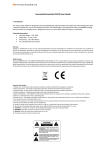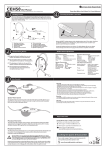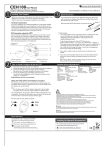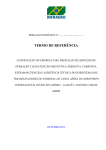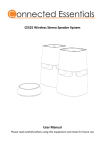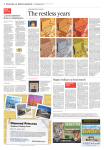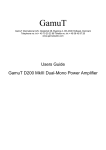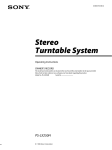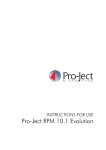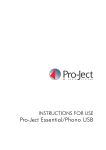Download CET-500 Belt Drive Turntable User Guide
Transcript
CET-500 Belt Drive Turntable User Guide Please read carefully before assembling and using this equipment and retain for future use. Time to enjoy your vinyl! In our digital world we are used to ‘plug and play’, however playing a record is something to be savoured. Likewise preparation is important to ensure your turntable not only operates correctly, but delivers the best possible audio quality and does not place undue strain and wear on your records. It is not difficult to set up a turntable; the principle of operation is simple, but as with a classic sports car the calibration and tuning determines the level of performance and satisfaction in use. We recommend taking a few minutes to carefully read this user guide and be prepared to test and adjust the tonearm settings to ensure all is operating correctly and your record deck is set up for optimum performance. Always take care to protect the stylus and tonearm, these are delicate items and damage is not covered under warranty. Latest advice and set up information can be found at www.connectedessentials.co.uk Page | 1 Important! 1. Please check carefully that you have unpacked all parts supplied. Your CET500 is carefully checked and shipped in packaging designed to protect in transit, all units and contents are 2. 3. 4. 5. checked before leaving the factory to be sure they are complete. The belt is located on the underside of the platter over the centre rim. Do not dispose of any packaging until you have established your unit is assembled and is operating correctly. Always take care to protect the stylus and tonearm, they are delicate parts. The stylus cover and the tonearm lock should always be put in place when not in use. Ensure that the mains voltage of your supply corresponds to the operating voltage of the unit. Your unit is ready to be connected to an AC mains voltage of 220V/50Hz. To use this product with a 110 Volt DC 60 HZ supply, you will need an approved and suitable plug adapter and also to change the position of the voltage selector switch located under the unit. ONLY operate the unit on the correct supply for your power outlet. If in any doubt always consult a qualified electrician . Please read and follow all recommendations and warnings in this manual for your safety. Position your turntable on a solid level surface that does not conduct vibration from its surroundings. What’s in the box? a) b) c) d) e) f) g) h) i) 1x CET-500 Turntable, 1x Cartridge with stylus and protective cover, 1x Platter with Drive Belt, 1x Turntable Mat, 1x Dust Cover, 2x Hinge, 1x USB Cable, 1 x Tonearm Counterweight 1x Centre adapter for hole ‘punched’ singles. Always take care to protect the stylus and tonearm, these are delicate items and damage is not covered under warranty. Latest advice and set up information can be found at www.connectedessentials.co.uk Page | 2 Getting To Know Your CET500 Please check carefully that you have unpacked all parts supplied. Your CET500 is carefully factory checked to ensure all parts are supplied and quality standards are met. We suggest you first familiarise yourself with your turntable before assembling. Fig.1 Platter & Tonearm View 1. 2. 3. 4. 5. 6. 7. 8. Tonearm Counterweight - use this to balance the tonearm. Careful setting is required. Anti-Skate Control - use this to set the anti-skating function of the tonearm. Tonearm Lever - use this to lower and raise the tonearm. Tonearm Lock - use this to lock the tonearm in place when not in use. Headshell - this holds the cartridge and stylus (‘needle’) in place and provides protection by means of its removable stylus protection cover (not shown). Adaptor - use this adaptor when playing 45 RPM records that have a ‘punched out’ centre. Platter – place your record here to play. 33/45 RPM Switch – switch between 33 or 45 rpm for playing at the correct speed. Platter and Tonearm View NB! Always take care to protect the stylus and tonearm, they are delicate parts. The stylus cover and tonearm lock should always be put in place when not in use. 9. Fig.2 Rear Panel View Rear Panel View Power Cord - connect this cord to a grounded AC outlet of the correct voltage. If a plug adapter is to be used only use an approved and suitable product. To use this product with a 110 Volt DC 60 HZ supply, you will need to change the position of the voltage selector switch located under the unit. ONLY operate the unit on the correct supply for your power outlet. If in any doubt consult a qualified electrician. 10. Power Switch – turn the power on or off by this switch. 11. Auto Stop Switch – when on, starts the turntable when the tonearm is moved into the proximity of the platter and stops the turntable when the end of a record is reached. If off position is selected, the platter will turn whenever the unit is switched on. NB Auto stop function will not work with some records. The tonearm is not designed to automatically return to the rest position. 12. USB Port - connect to a PC for converting records to digital format with your chosen software. 13. Audio Output Connectors - use these to connect the turntable to your amplifier or audio system (unit). Always take care to protect the stylus and tonearm, these are delicate items and damage is not covered under warranty. Latest advice and set up information can be found at www.connectedessentials.co.uk Page | 3 Setting Up Your CET500 Amplifier/Audio System Connection Connect audio output plugs to the magnetic record player or ‘phono’ input on your amplifier or audio system. The CET-500 has an inbuilt pre-amplifier so will also work with most ‘Aux in’ inputs. If you have multiple inputs on your unit you can try connecting to each input and testing which works and gives the best audio performance, of course be sure to select (switch) the input you wish to use. NB! Only connect to an input socket, damage to your equipment may occur if connected incorrectly. 1. 2. Red plug into R/H channel input. White plug into L/H channel input. Platter and Drive Belt: 1. 2. 3. 4. 5. Attach the belt to the underside of the platter on the round rim which is located around the centre of the platter (making sure it is secure and not twisted). Place the platter the correct way up and locate on the centre spindle of the turntable. Check the platter turns freely. Turn the platter round until one of the two access holes is aligned with the drive spindle. This is located under the platter, adjacent to the 33/44rpm switch (Fig. 1, part 8). Using your forefinger and thumb, gently pull the belt away from the platter and place over the drive spindle, ensure it remains securely located on the platter rim and is located in the groove on the drive spindle. Check the platter rotates freely; you will feel some resistance from the belt now being in place on the drive spindle. Place the turntable mat over the centre spindle and on to the turntable. Installing The Cartridge 1. 2. 3. Carefully unpack the cartridge without removing the stylus protective cover. Install the cartridge/headshell into the front of the tonearm. Tighten the locking collar to lock the cartridge/headshell in place. Always take care to protect the stylus and tonearm, these are delicate items and damage is not covered under warranty. Latest advice and set up information can be found at www.connectedessentials.co.uk Page | 4 Installing The Dust Cover 1. 2. 3. Carefully remove the dust cover and 2 hinges from its protective packaging. Install the hinges on to the dedicated “cut outs” on the rear of the dust cover. Once both hinges are attached, gently slot these in place at the rear of the turntable. Tonearm and Counterweight 1. 2. 3. 4. 5. 6. Select ‘Zero’ on the counterweight dial settings. NB! The weight setting dial moves freely to that of the tonearm counterweight when adjusting on the tonearm. Take care. With the tonearm locked in place, ensure the anti-skate position (to the side of the tonearm) is set to "0" and whilst holding the tonearm, gently push the counterweight onto the rear of the tonearm. NB! Make sure that the numbers (settings) face to the front of the turntable so you can easily see them. Turn the weight (not the dial) until you feel it "click" into place. You can check it is in place as when you turn the counterweight it should now move up and down the tonearm to increase/decrease the counterbalance weight. With a record on the turntable, carefully remove the stylus protective cover and unlock the tonearm from the rest. Move the tonearm toward the record position about one inch from the edge of the platter. Hold the arm off the surface with your hand. Begin turning the counterweight one way or the other, until the arm floats in a neutral position. NB! You can check this is set correctly by applying a slight increase in weight (turn the counterbalance anti-clockwise), and a slight decrease in weight (turn the counterbalance clockwise). These adjustments should weigh the tonearm up and down when it is left to float. When properly adjusted the tonearm will be balanced and will not settle up or down; it will stay parallel with the platter as you positioned it. NB! It may take a few tries to get this correct. Once the balance is correct and checked you can now adjust the counterweight dial setting to zero ‘0’. With the dial at this position the arm is floating and will not settle on the record. You can now set the tonearm weight by adjusting the counterweight. The dial will now show the weight to be applied. For use with records in good condition we recommend a setting of 2.5 g. Tonearm and Anti-Skate Anti-skate counteracts the tone arm to ensure it tracks without undue stress. Normally the anti-skate setting should be the same as the tracking weight on the cartridge which is recommended at 2.5 g. However, settings vary and you may need to experiment with adjustments. If the anti-skate setting is incorrect the tonearm may ‘skip’ across the record being played or pull to the side. A good method to test settings is to raise the tone arm using the tonearm lever and place the stylus above the groove on a playing record. When lowered the tonearm should descend vertically straight, so when raising and lowering the tonearm it locates approximately in the same place on the record each time. Playing a Record 1. 2. 3. Choose the required playing speed by toggling the speed selector switch. Remove the protective stylus cover and release the pick-up arm clip. Place the cartridge vertically over the first track of the record the turntable will start turning. Use the tonearm lever to lower the tonearm. Always take care to protect the stylus and tonearm, these are delicate items and damage is not covered under warranty. Latest advice and set up information can be found at www.connectedessentials.co.uk Page | 5 Converting your records to digital format The CET500 is equipped with a USB output, so you can connect your turntable with the USB cable provided to a computer (PC) to convert records to your chosen digital format; MP3, AAC, WAV etc to play on a portable music player. To carry out a conversion you will need a computer and software. Various software programs (paid for and freeware) are available to carry out this task. Audacity for example is a freeware program, http://audacity.sourceforge.net/. Many PC’s will come with suitable software pre-loaded. NB! Conversion is a computer and software function so its use is not covered by this manual or our product support service. Always take care to protect the stylus and tonearm, these are delicate items and damage is not covered under warranty. Latest advice and set up information can be found at www.connectedessentials.co.uk Page | 6 Maintenance Replacing The Stylus (Fig.3) Handle With Care! - Put the rest clip in place on the pick-up arm. Remove the protective cap from the stylus. Gently pull the stylus in the direction of arrow (A) and remove it. Fit the new stylus following the reverse procedure. Fig.3 Replacing The Stylus Disassembling The Cartridge (Fig.4) Handle With Care! - Put the rest clip in place on the pick-up arm. Remove the stylus (see section above). Release the screws to disassemble the cartridge and headshell. Disconnect the four link wires at the level of the pick-up head. Fig.4 Disassembling The Cartridge NB Make a note of the connection order of each wire, for use when refitting. IMPORTANT RECOMMENDATIONS - We advise you to clean your records using a specialist record cleaning cloth or brush impregnated with antistatic properties. For the best performance your stylus should be replaced periodically (approximately every 250 hours). Dust the stylus from time to time using a very soft brush dipped in alcohol (brushing carefully from back to front of the cartridge). Always take care to protect the stylus and tonearm, these are delicate items and damage is not covered under warranty. Latest advice and set up information can be found at www.connectedessentials.co.uk Page | 7 Troubleshooting How do I connect the turntable to my amplifier? The CET500 can be connected to various inputs on your amplifier or dock (your unit). Look for inputs marked ‘Aux in’ or ‘Line in’. Some amplifiers have Phono input sockets. You can try connecting to the inputs on your unit and testing which works and gives the best audio performance, of course be sure to select the input you wish to use. The phono input (if you have one) is usually the best place to start. Please note that the CET500 features a built in pre amplifier and connecting it via a phono socket may cause the sound to be distorted if your unit is designed to work with a record deck without pre-amp, if that is the case please use an alternative socket. IMPORTANT: be sure to only connect the audio output from your CET 500 to an input socket, if connected to another type of socket you may cause damage to your equipment. I seem to be getting a distorted sound when connecting to my amplifier. This is most likely the case if you are connecting the CET500 to a phono socket on your amplifier, that has been designed to work with a record deck without a pre-amp. Please try an alternative socket. If this does not solve your problem, try connecting the CET500 to a different device to verify it is working correctly. Contact amplifier manufacturer for further information. I seem to be getting crackling interference or a muffled sound when playing records. This is usually a result of incorrect settings, perhaps the counterweight or anti-skate are calibrated incorrectly. Please follow the Tonearm and anti-skate adjustments section in the user manual. Correct setting of the anti-skate function and counter balance is important for audio quality and to prevent damage to your records. Also check your record is clean and damage free, records should only be cleaned using recommended cleaners. Your may need to remove dust from your stylus from time to time. Take great care when cleaning to avoid damage; we recommend use of a specialist cleaning kit. Is recording software included? Conversion to mp3 is a PC and software function so its use is not covered by our product support service. If you do not already own software that could assist with that function (your Mac or PC may already have suitable software installed), various programs (paid for and freeware) are available to carry out this task. Audacity for example is a freeware program, http://audacity.sourceforge.net/ Always take care to protect the stylus and tonearm, these are delicate items and damage is not covered under warranty. Latest advice and set up information can be found at www.connectedessentials.co.uk Page | 8 I am missing parts. Please check carefully that you have unpacked all parts supplied. Your CET500 is carefully checked and shipped in extensive packaging to protect in transit, all units and contents are checked before leaving the factory to be sure they are complete. The belt is located on the underside of the platter – it is placed over the centre rim. Do not dispose of any packaging until you have established your unit is assembled and is operating correctly. I require spares – where can I get replacement items? Spares are available from our nominated distributor Wire Free AV. It all seems a bit fussy setting a record deck up? In our digital world we are used to ‘plug and play’ or ‘push and go’, however a record is like a fine wine, something to be savoured and looked after carefully. Likewise preparation is important to ensure your turntable not only operates correctly but delivers the best possible audio quality and does not place undue strain and wear on your records. It is not difficult to set up a turntable, the principle of operation is simple, but as with a classic sports car the calibration and tuning determines the level of performance and satisfaction in use. We recommend taking a few minutes to carefully read set up instructions and be prepared to test and adjust to ensure all is operating correctly and your record deck is set up for best performance. Many articles and videos are available on the internet describing how to fine tune and set up a record deck. Whilst set up differences will exist between record deck manufacturers specifications and instructions, the general principles of tone arm set up for anti-skate and weight adjustment are very similar. My tone arm will not travel the full record without jumping or skimming the record surface. With the stylus cover in place (always protect your stylus, it is delicate) and the auto return switch set to off, carefully move the arm from its rest to the centre of the record taking care to keep it above the surface of the record. If it moves smoothly without resistance, the problem is most likely to due to incorrect setting of tone arm weight, and/or anti-skate, or your record is damaged. Click here to view our tonearm set up guide. When playing some records they jump, but this is not the case with others that don’t jump and play ok. Is the record that jumps damaged? Scratches are not always obvious to the naked eye. Also consider the actual quality of the record itself. The smaller the groove and closer together the tracks, the lower the audio output and sound quality. This is typical of compilation albums, where smaller grooves allow more tracks to be included on a record, but this is at the expense of sound quality. It also means jumping of the stylus is more likely as the groove is not as deep as a standard album. The sound quality of 12” single is normally deemed to be the highest as more room is available to create deeper grooves in the record pressing process and most 12” singles play at 45 R.P.M. Bigger grooves and faster playback speed equals better sound quality and more tolerance to stylus jump. Always take care to protect the stylus and tonearm, these are delicate items and damage is not covered under warranty. Latest advice and set up information can be found at www.connectedessentials.co.uk Page | 9 I can hear rumble from my speakers when I play a record. It is likely this is due to either record wear or audio feedback reaching the stylus/deck or vibrations from whatever the record deck is mounted on. Your record deck should be placed on a solid surface/stand that is level and does not transmit vibrations from its surroundings. A stylus and cartridge will amplify whatever is picked up including vibrations and feedback from its surroundings. Dedicated Hi Fi enthusiasts with high end systems go to great lengths to isolate the turntable from its environment. Most of us don’t need to go to such lengths, a solid surface or better still a specialist Hi Fi rack will provide enough isolation. Why is anti-skate and counter weight setting important? Anti-Skate is a feature that exerts a force counter to the one pulling the tonearm across the record, so to prevent the arm skating. A Tone arm is designed to be pulled freely without resistance across the grooves of the record as it turns. The record revolving and the grooves do the work. The tone arm and stylus need to be set so to allow the arm to move freely and follow the grooves with the stylus sitting evenly and straight in the groove. If it is pulled to one side it will negatively affect sound quality, skate across the record and at the very least accelerate wear of your records. Weight is carefully set to ensure best sound quality, to avoid the stylus jumping out of the grooves and ensure minimal wear to a record. My records seem to be playing at inconsistent speed. There are several factors that could potentially cause this problem. In order to eliminate these please first check that the correct speed is selected on top of the turntable. Following on from that, please verify that the belt is fitted correctly and securely. If both of these are confirmed as correct, please check your record for damages or warping. The tonearm is skipping across records. If you are experiencing skipping, this is most likely caused by an incorrect weight and/or anti-skate setting. Please follow the Tonearm and anti-skate adjustments section in the user manual. Correct setting of the anti-skate function and counter balance is important for audio quality and to prevent damage to your records. Also check your record is clean and damage free, records should only be cleaned using recommended cleaners. You may need to remove dust from your stylus from time to time. Take great care when cleaning to avoid damage, we recommend use of a specialist cleaning kit. I cannot hear any audio from the turntable. Please ensure the turntable is connected correctly to your amplifier or equipment. Look for inputs marked ‘Aux in’, or ‘Line in’ on your audio device. Some amplifiers have Phono input sockets. You can try connecting to the inputs on your unit and testing which works and gives the best audio performance, of course be sure to select the input you wish to use. Always take care to protect the stylus and tonearm, these are delicate items and damage is not covered under warranty. Latest advice and set up information can be found at www.connectedessentials.co.uk Page | 10 Warning: Changes or modifications to this unit not expressly approved by the party responsible for compliance could void the users authority to operate the equipment. Operation is subject to the following two conditions: (1) this device may not cause interference, and (2) this device must accept any interference, including interference that may cause undesired operation of the device. Further information can be found at www.connectedessentials.co.uk. WEEE Directive Directive 2002/96/EC OF THE EUROPEAN PARLIAMENT AND COUNCIL OF 27th January 2003 on waste electrical equipment. Products that include the WEEE symbol shown below should not be placed in the normal household waste, but should be disposed of using the appropriate WEEE disposal facility. Those facilities may be advised to you by your local council or organisation from which the product(s) was purchased. For the latest information on the WEEE directive please access the following website www.environment-agency.gov.uk/weee. Important Information: 1. Please note - All the safety and operating instructions should be read before the appliance is operated. 2. Retain Instructions - The safety and operating instructions should be retained for future reference. 3. Heed Warnings - All warning on the appliance and in the operating instructions should be adhered to. 4. Follow Instructions - All operating and usage instructions should be followed. 5. Water and Moisture - The appliance should not be used near water, for example, near a bathtub, washbowl, kitchen sink, washing machine, in a wet basement or near a swimming pool. 6. Power Sources - The appliance should be powered only as described in these operating instructions or as marked on the appliance. 7. Do not leave the unit unattended while in use. 8. This electric product is not a toy! To avoid risk of fire, burns, personal injury and electric shock keep out of reach of children. 9. Do not use this product for other than its intended use. 10. Do not close doors or windows on the product or extension cords as this may damage the wire insulation. 11. Electrical ratings of the extension cord must be as high as, or higher than the electrical ratings of the product. 12. Do not cover the product with cloth, paper or any material that is not part of the product when it is in use. 13. CAUTION: to reduce the risk of fire do not deliberately reposition pins on the plug assembly. 14. WARNING: Keep unit and power cord out of reach of children. 15. ALWAYS: switch off the turntable at the mains socket when not in use. 16. No repair should be carried out by the user 17. WARNING: A cut off plug inserted into a 13 amp socket is a serious safety shock hazard. Ensure the cut off plug is disposed of safely Always take care to protect the stylus and tonearm, these are delicate items and damage is not covered under warranty. Latest advice and set up information can be found at www.connectedessentials.co.uk Page | 11 UK Wiring Instructions 1. Your Electric plug includes a moulded BS 13 amp (fused) on the supply cord. 2. Should it be necessary at any stage to replace the moulded plug or cord, it must be replaced with the correct part which includes a suitable moulded fused plug. (NB The original moulded plug and lead should be disposed of safely) Class I (1) Earthed Appliance The wires in the mains lead are coloured in accordance with the following code: GREEN & YELLOW = EARTH BLUE = NEUTRAL BROWN = LIVE 1. The wire which is coloured GREEN and YELLOW must be connected to the terminal in the plug which is marked with the letter E. 2. The wire which is coloured BLUE must be connected to the terminal which is marked with the letter N. 3. The wire which is coloured BROWN must be connected to the terminal which is marked with the letter L. With this appliance, a suitable fuse of 13 amps must always be fitted, in the plug. Version 2. Effective 01/01/2014 Always take care to protect the stylus and tonearm, these are delicate items and damage is not covered under warranty. Latest advice and set up information can be found at www.connectedessentials.co.uk Page | 12













